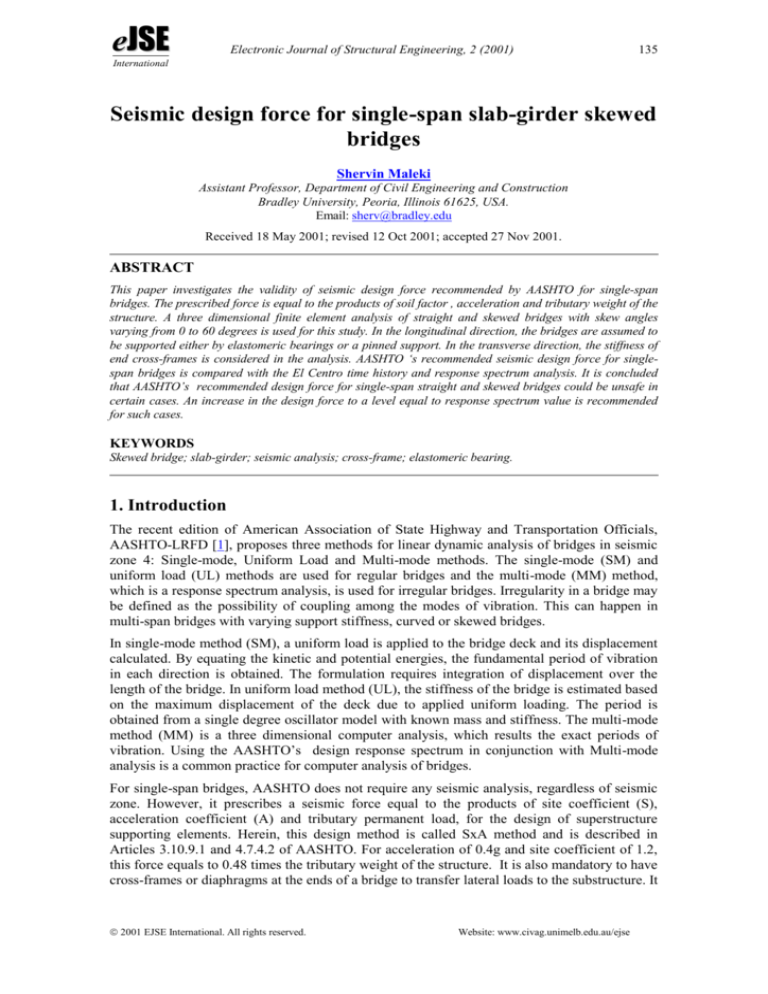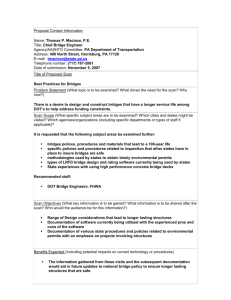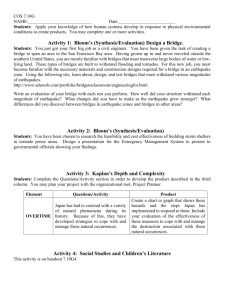
eJSE
Electronic Journal of Structural Engineering, 2 (2001)
135
International
Seismic design force for single-span slab-girder skewed
bridges
Shervin Maleki
Assistant Professor, Department of Civil Engineering and Construction
Bradley University, Peoria, Illinois 61625, USA.
Email: sherv@bradley.edu
Received 18 May 2001; revised 12 Oct 2001; accepted 27 Nov 2001.
ABSTRACT
This paper investigates the validity of seismic design force recommended by AASHTO for single-span
bridges. The prescribed force is equal to the products of soil factor , acceleration and tributary weight of the
structure. A three dimensional finite element analysis of straight and skewed bridges with skew angles
varying from 0 to 60 degrees is used for this study. In the longitudinal direction, the bridges are assumed to
be supported either by elastomeric bearings or a pinned support. In the transverse direction, the stiffness of
end cross-frames is considered in the analysis. AASHTO ‘s recommended seismic design force for singlespan bridges is compared with the El Centro time history and response spectrum analysis. It is concluded
that AASHTO’s recommended design force for single-span straight and skewed bridges could be unsafe in
certain cases. An increase in the design force to a level equal to response spectrum value is recommended
for such cases.
KEYWORDS
Skewed bridge; slab-girder; seismic analysis; cross-frame; elastomeric bearing.
1. Introduction
The recent edition of American Association of State Highway and Transportation Officials,
AASHTO-LRFD [1], proposes three methods for linear dynamic analysis of bridges in seismic
zone 4: Single-mode, Uniform Load and Multi-mode methods. The single-mode (SM) and
uniform load (UL) methods are used for regular bridges and the multi-mode (MM) method,
which is a response spectrum analysis, is used for irregular bridges. Irregularity in a bridge may
be defined as the possibility of coupling among the modes of vibration. This can happen in
multi-span bridges with varying support stiffness, curved or skewed bridges.
In single-mode method (SM), a uniform load is applied to the bridge deck and its displacement
calculated. By equating the kinetic and potential energies, the fundamental period of vibration
in each direction is obtained. The formulation requires integration of displacement over the
length of the bridge. In uniform load method (UL), the stiffness of the bridge is estimated based
on the maximum displacement of the deck due to applied uniform loading. The period is
obtained from a single degree oscillator model with known mass and stiffness. The multi-mode
method (MM) is a three dimensional computer analysis, which results the exact periods of
vibration. Using the AASHTO’s design response spectrum in conjunction with Multi-mode
analysis is a common practice for computer analysis of bridges.
For single-span bridges, AASHTO does not require any seismic analysis, regardless of seismic
zone. However, it prescribes a seismic force equal to the products of site coefficient (S),
acceleration coefficient (A) and tributary permanent load, for the design of superstructure
supporting elements. Herein, this design method is called SxA method and is described in
Articles 3.10.9.1 and 4.7.4.2 of AASHTO. For acceleration of 0.4g and site coefficient of 1.2,
this force equals to 0.48 times the tributary weight of the structure. It is also mandatory to have
cross-frames or diaphragms at the ends of a bridge to transfer lateral loads to the substructure. It
2001 EJSE International. All rights reserved.
Website: www.civag.unimelb.edu.au/ejse
eJSE
Electronic Journal of Structural Engineering, 2 (2001)
136
International
is implicitly understood that the code intends to use the above force for the design of crossframes and bearings of single-span bridges, as well. In addition, AASHTO article 4.6.2.8.2,
requires such members to be designed and detailed to remain elastic. However, as will be
shown later, AASHTO’s design response spectrum (RS) can yield much higher forces for crossframes and bearings.
It is the objective of this paper to assess the accuracy of SxA method for single-span straight
and skewed bridges with possible elastomeric bearing support in the longitudinal direction and
end cross-frames in the direction of skew. Three dimensional finite element models of slabgirder bridges with elastic supports and skew angles of 0,15,30,45 and 60 degrees are used in
this study. Bridge spans of 10m, 15m and 30m with widths of 10m and 14m are analyzed with
SAP2000[2] finite element program. In each case the SxA method is compared with
AASHTO’s multi-mode (MM) response spectrum analysis and a typical time history (TH)
analysis using El Centro ground motion.
A survey of literature shows that the validity of SxA method for single-span bridges with elastic
supports has not been investigated. However, seismic response of skewed slab-on-girder
bridges supported elastically has been studied by the author [3,4,5] previously. Zahrai and
Bruneau [6] have considered the effect of cross-frame stiffness on the seismic response of
straight bridges.
SKEW ANGLE =
C
L
SPAN, L
END CROSS-FRAME
CL
GIRDER
C
L
Y
T
W=10 or 14 m
2.0 m
GIRDER
C
L
GIRDER
C
L
BEARING
N
X
2.0 m
2.0 m
GIRDER
2.0 m
C
L
GIRDER
EXP. JOINT
BACK WALL
ABUT. SEAT
Fig. 1- Typical Skewed Bridge Plan View
2.0 m
Brg. stiff.
Typ.
2.0 m
W12x40
W12x40
W12x40
W12x40
L3x3x5/16
L3x3x5/16
L3x3x5/16
L3x3x5/16
L4x4x1/4
L4x4x1/4
L4x4x1/4
L4x4x1/4
Fig. 2- Cross-frame Detail
ELASTOMERIC
EXP. BRG.
GIRDER BOTTOM
FLANGE
Gap
SIDE RETAINER
ANCHOR BOLT
Fig. 3- Elastomeric Bearing Detail
2001 EJSE International. All rights reserved.
Website: www.civag.unimelb.edu.au/ejse
eJSE
Electronic Journal of Structural Engineering, 2 (2001)
137
International
2. Finite element models
A typical plan view of a skewed slab-girder bridge is shown in Fig. 1. These bridges are
normally limited to a span of 20 meters with composite action between slab and steel girder.
The concrete slab has a minimum thickness of 190 mm and sits on top of a steel rolled shape
girder. The cross-sectional view of the bridge over the abutment depicting an end cross-frame is
shown in Fig. 2. The elastomeric bearing detail is shown in Fig. 3. The cross-frame and bearing
details are standard in the state of Illinois [7].
Note that the bridge and its support stiffness are symmetric and the centers of mass and rigidity
coincide. Hence, the bridge will not be subjected to torsional vibration, unless the base motion
is torsional. Furthermore, for single-span bridges the abutment stiffness is ignored. The
justification for this assumption is described herein. Single-span bridges usually have an
expansion joint, at least on one side. A gap separates the deck from abutment backwall. This
gap has no effect on the transverse and longitudinal vibration of a bridge. Only in an extreme
event activity in the longitudinal direction, the gap could close and the deck could impact the
backwall. This study is only concerned with linear elastic behavior under Design Earthquake.
The impact effect and non-linear behavior under Maximum Credible Earthquake are ignored.
The finite element model of the same bridge is shown in Fig. 4. SAP2000 finite element
program [2] is used for analysis. The model has two displacement degrees of freedom, ux, uy,
and one rotational, uSince cross-frames and lateral load resisting elements of the
superstructure are supposed to remain elastic under earthquake forces, only linear dynamic
analysis is performed on the models. This is consistent with AASHTO article 4.6.2.8.2.
SKEW ANGLE=
Beam
Element(Typ.)
ks
Shell Element (Typ.)
Bearing
Stiffness(Typ.)
ks
ks
kc/2
ks
kc/2
uy
kc
ks
kc
ks
ux
ks
kc
ks
u
kc
ks
kc
kc
ks
kc/2
kc/2
Cross-Frame
Stiffness(Typ.)
Fig. 4- Typical Finite Element Bridge Analysis model
The springs ke represent the stiffness of elastomeric bearing in the X direction, and springs k c
represent the stiffness of the end cross-frames in the T direction. For the end girders only half
of kc is used. End cross-frames provide an important load-path for the seismically induced
loads. Seismic forces at the deck would have to pass through the cross-frames to arrive at the
top of bearings. Zahrai and Bruneau [6], have shown that intermediate cross-frames do not
affect the seismic performance of slab-girder bridges significantly. Hence, they are not
considered in the model.
Note that abutment stiffness is not modeled. Abutments are, in general, much stiffer than crossframes and elastomers. Since abutments and these elements are, in effect, springs connected in
series, the equivalent spring has a stiffness equal to cross-frame or elastomeric bearing.
However, an extreme case of having a pinned support at one end of the bridge, in the
longitudinal direction, is considered.
2001 EJSE International. All rights reserved.
Website: www.civag.unimelb.edu.au/ejse
eJSE
Electronic Journal of Structural Engineering, 2 (2001)
138
International
The deck slab is modeled with rectangular shell elements. The girders are modeled with frame
elements connected to shell elements at each joint. They are free to rotate but restrained
vertically at each end. This will capture the contribution of girders’ weak-axis moment of
inertia to the superstructure stiffness for transverse loading. In the longitudinal direction, the
end of the girder is attached to a spring representing the elastomer’s lateral stiffness. The
modeling of superstructure is consistent with recommendations of Mabsout et al. [8].
The mass of the bridge is assumed to be uniformly distributed over the bridge deck and it is
assigned as mass density to the shell elements. To consider the effect of bridge geometry, span
lengths of 10m, 20m and 30m and widths of 10m and 14m are considered in the analyses. This
covers short, medium and long span slab-girder bridges. The change in width considers the
effect of mass on the response. The author has found that the effect of width is negligible and
showing the results for 10m and 14m widths proves this point. This is due to the fact that with
higher widths more girders and bearings are added and the cross brace is also extended. This
will increase stiffness in all directions and compensates for the increase in mass. Hence, the
support reactions are not affected substantially. Note that if the number of girders is not
increased for wider bridges, then the spacing between girders must be increased. This is usually
not done in practice, because it leads to thick concrete slabs and an uneconomical design. The
usual spacing in slab-girder bridges is kept in the range of 1.5-2.5 meters. In all examples to
follow a spacing of 2 meters is assumed.
The mesh sizes used for shell elements, girder sizes, spring constants kc and ke, and other
dimensions and properties of bridges used in the analyses are given in Table 1. Note that spring
constants represent typical practical values used for these bridges and correspond to details
shown in Figs. 2 and 3.
Table 1- Bridge Properties Used in Analyses
Span (m)
10
20
30
10
20
30
Width
(m)
10
10
10
14
14
14
Deck
Thk. (m)
0.19
0.19
0.19
0.19
0.19
0.19
Girder Size
(US Std.)
W30x99
W40x221
W40x268
W30x99
W40x221
W40x268
Number of
Girders
6
6
6
8
8
8
Shell
Size (m)
2x2
2x2
2x3
2x2
2x2
2x3
Elastomer
Ke (kN/m)
1000
1000
1000
1000
1000
1000
Cross-frame
Kc (kN/m)
162338
162338
162338
162338
162338
162338
Mass (kg)
54450
130500
208500
75600
180000
287000
The models described above are analyzed using SAP2000 program under three loading
conditions. These are SxA force, AASHTO’s response spectrum force and forces from El
Centro ground motion. The loads are discussed and compared in the next section.
3. Seismic design force for bridges
As explained earlier, according to AASHTO Article 4.7.4.2, single-span bridges require no
seismic analysis and only the connection of the superstructure to substructure is designed for an
acceleration of SxA; where, A is the peak ground acceleration for the seismic zone and S is the
site coefficient. For soil type II, the coefficient S is equal to 1.2. Therefore, supporting elements
have to be designed for a force equal to 1.2A times the tributary weight. It is interesting to note
that choosing the more elaborate response spectrum (RS) analysis method yields a design force
equal to 2.5A times the tributary weight for pin supported bridges. This is because single-span
slab-girder bridges with pinned supports have a very low period and in that range (below 0.44
sec.) AASHTO’s response spectrum shows a constant acceleration of 2.5A for soil types I and
II. This is more than twice the recommended 1.2A force for soil type II, per SxA method.
However, the fundamental period of vibration can be higher than 0.44 seconds when the bridge
is supported on elastomeric bearings on both sides.
2001 EJSE International. All rights reserved.
Website: www.civag.unimelb.edu.au/ejse
eJSE
Electronic Journal of Structural Engineering, 2 (2001)
139
International
To investigate the accuracy of SxA force for single-span bridges, the bridge models are
subjected to a response spectrum with constant acceleration of (SxA=1.2x0.4g=)0.48g in two
orthogonal directions. The results are compared with AASHTO’s design response spectrum for
soil type II, with peak ground acceleration A=0.4, and a response modification factor R=1. In
addition, a linear dynamic time history analysis using El Centro accelerogram with 2% damping
is performed on the models, for illustrative purposes. The force demand on supporting
elements, such as, elastomeric bearings, pinned supports and cross-frames, are compared for all
three loading cases.
Figs. 5a-5c show the variation of elastomeric shear force versus span length for a bridge
supported on elastomeric bearings on each side for the three loading conditions discussed
above. Figs. 5d-5f are the plots of the same variables for a bridge pinned at one end and free at
the other end. The plots in Fig. 5 are for a 10 m wide bridge. The same variables are plotted in
Fig. 6 for a 14m wide bridge. In each case, the shear force is the reaction of an individual k e
spring of the analysis model.
Comparing Fig. 5 and Fig.6, it is observed that the bridge width (or mass) is not a factor in the
conclusions to be drawn. This was discussed in the previous section and expected. In all cases,
and for all loading conditions, it is concluded that the reaction shear force in the longitudinal
direction increases with increasing span lengths. However, bridges with 45 degrees skew or
higher, and with span lengths of 30m behave erratically under time history loading. The
behavior is highly dependent on the frequency content of the input motion. Higher modes of
vibration and torsional modes contribute to the behavior of these long-span highly skewed
bridges. In addition, for bridges with skew angles over 45 degrees, the maximum response
reverses its direction. This means that the maximum reaction in the X-direction is obtained by
applying the earthquake motion in the Y-direction and vice-versa. Comparing parts (a) and (c)
or parts (d) and (f) of Figs. 5 or 6, it is concluded that using the SxA method can be highly
unsafe for these kinds of bridges.
For ordinary bridges, supported on elastomeric bearings, the SxA force yields lower reaction
than response spectrum and time history analyses. For pin supported bridges, SxA yields lower
forces than response spectrum and higher forces than El Centro time history.
Note that the periods in the longitudinal direction are several times lower for pin supported
bridges than bridges supported on elastomers. This varies the force demand in response
spectrum and time history analyses for pinned bearings, but the SxA method remains
unaffected, because it is not period dependent.
Fig. 7 shows the variation of cross-frame shear force versus span length for different skew
angles and support conditions for a 10m wide bridge. Fig. 8 shows the same variables for a 14m
wide bridge. Comparing the two figures indicates that the trend in behavior is the same.
It is observed that the cross-brace shear force increases with increasing span lengths. The shear
is almost the same for all skew angles ranging from 0 to 30 degrees. However, for skews of 45
degrees or higher the force increases with increasing skew angle. In all cases, the response
spectrum method has yielded a higher force than SxA method. Time history analysis has
yielded a lower force than SxA method in all cases, except for 30 m span with 60 degrees skew
(Fig. 6(f)) in a pin supported bridge. This indicates that long-span and highly skewed bridges
require special attention and the actual forces induced in supporting members can be several
times higher than SxA method. However, even in an extreme case described above, the forces
are lower than the response spectrum method.
2001 EJSE International. All rights reserved.
Website: www.civag.unimelb.edu.au/ejse
eJSE
Electronic Journal of Structural Engineering, 2 (2001)
International
2001 EJSE International. All rights reserved.
Website: www.civag.unimelb.edu.au/ejse
140
eJSE
Electronic Journal of Structural Engineering, 2 (2001)
International
2001 EJSE International. All rights reserved.
Website: www.civag.unimelb.edu.au/ejse
141
eJSE
Electronic Journal of Structural Engineering, 2 (2001)
142
International
It is concluded that AASHTO’s design response spectrum is conservative for both transverse
and longitudinal vibrations and for all ranges of support stiffness. For short to medium span
ranges of pin supported bridges, the SxA method yields acceptable force demand in the
supporting members. However, in other cases, the SxA method yields unsafe results.
The author recommends that the design force for single-span bridges, in seismic zones 3 and 4,
be changed to 2.5xA. This is almost equal to peak value of the design response spectrum for
soil types I and II. The above discussion and Figs. 5-8 have shown that this value is
conservative for all cases. Alternatively, for bridges with periods higher than 0.44 seconds, a
response spectrum analysis can be performed to yield a more economical design.
4. Conclusions
Analytical study of single-span slab-girder bridges with spans ranging from 10 to 30 meters,
and widths of 10 and 14 meters, has revealed that the prescribed seismic force by AASHTO
Articles 3.10.9.1 and 4.7.4.2 (SxA method) can lead to analysis forces that are lower than
response spectrum (RS) method. Both straight and skewed bridges have been considered in this
study. In addition the longitudinal girder support was examined under two cases of elastomeric
and pinned support. A linear dynamic three dimensional finite element analysis was utilized.
Results from AASHTO‘s response spectrum analysis were compared to SxA force method. The
design RS of AASHTO represents an ensemble of design basis earthquakes and is taken as a
prime measure of safety here. A time history analysis based on El Centro ground motion was
also added for illustrative purposes. It was shown that AASHTO’s RS yields more conservative
results for both transverse and longitudinal vibrations and for all ranges of support stiffness.
However, time history analysis can yield support shears several times higher than SxA method.
Since El Centro is a typical design basis earthquake with a peak ground acceleration of only
0.32g, the SxA method is considered unsafe for design. The author recommends that the design
force for single-span bridges, in seismic zones 3 and 4, be changed to 2.5xA. This is equal to
peak value of AASHTO’s design response spectrum for soil types I and II and it is conservative
for all cases.
REFERENCES
1.
2.
3.
4.
5.
6.
7.
8.
AASHTO, “LRFD Bridge Design Specification”, 2nd Edition, American Association of
State Highway and Transportation Officials , Washington, D.C. 1998.
Computers and Structures, Inc., SAP2000 , Version 7.4, Integrated Structural Analysis and
Design Software. Berkeley, CA, 2000.
S. Maleki, “Effect of Elastomeric Bearings on Seismic Response of Skewed Bridges”,
Proceedings 5th International
Conference on Computational Structures Technology,
Civil-Comp Press, 2000, pp. 77-182.
S. Maleki, “ Free Vibration of Skewed Bridges", Journal of Vibration & Control, 2001, in
print.
S. Maleki, “Effect of Diaphragms on Seismic Response of Skewed Bridges", Proceedings
of The 1st MIT Conference on Computational Fluid & Solid Mechanics, Elsevier Science,
2001.
S.M. Zahrai, M. Bruneau, “Impact of Diaphragms on Seismic Response of Straight Slabon-Girder Steel Bridges”, Journal of Structural Engineering-ASCE, Vol. 124, No.8,
1998,pp. 938-947.
Illinois Department of Transportation, Bridge Manual, Springfield, Illinois, 1999.
M.E. Mabsout, K.M. Tarhini,G.R. Frederick, C. Tayar, “Finite Element Analysis of Steel
Girder Highway Bridges”, Journal of Bridge Engineering-ASCE, Vol.2, No.3, 1997, pp.
83-87.
2001 EJSE International. All rights reserved.
Website: www.civag.unimelb.edu.au/ejse





